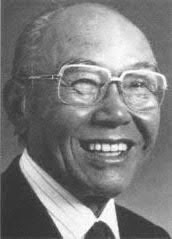Soichiro Honda (本田 宗一郎 Honda Sōichirō, November 17, 1906 – August 5, 1991) was a Japanese engineer and industrialist. In 1948, he established Honda Motor Co., Ltd. and oversaw its expansion from a wooden shack manufacturing bicycle motors to a multinational automobile and motorcycle manufacturer.
Early Years
Honda was born in Tenryū, Shizuoka, a small village under Mount Fuji near Hamamatsu on November 17, 1906. He spent his early childhood helping his father, Gihei, a blacksmith, with his bicycle repair business. At the time his mother, Mika, was a weaver. Honda was not interested in traditional education. His school handed grade reports to the children, but required that they be returned stamped with the family seal, to make sure that a parent had seen it. Soichiro created a stamp to forge his family seal out of a used rubber bicycle pedal cover. The fraud was soon discovered when Honda started to make forged stamps for other children. Honda was unaware that the stamp was supposed to be mirror-imaged. His family name 本田 was symmetrical when written vertically, so it did not cause a problem, but some of other children's family names were not.
Indeed, even as a little child, Honda had been excited by the primary vehicle that was ever found in his town, and frequently used to state in later life that he would always remember the smell of oil it emitted. Soichiro once obtained one of his dad's bikes to see an exhibition of a plane made by pilot Craftsmanship Smith, which solidified his affection for hardware and creation.
At 15, with no formal training, Honda left home and went to Tokyo to search for work. He acquired an apprenticeship at a carport in 1922, and after some wavering over his work, he remained for a long time, filling in as a grease monkey before returning home to begin his own auto fix business in 1928 at 22 years old.
Honda raced a turbocharged Ford in the "1st Japan Automobile Race" at Tamagawa Speedway in 1936. He crashed and seriously injured his left eye. His brother was also injured. After that, he quit racing.
Development of Honda Motor Co., Ltd.
In 1937, Honda founded Tōkai Seiki to produce piston rings for Toyota. During World War II, a US B-29 bomber attack destroyed Tōkai Seiki's Yamashita plant in 1944 and the Iwata plant collapsed in the 1945 Mikawa earthquake. After the war, Honda sold the salvageable remains of the company to Toyota for ¥450,000 and used the proceeds to found the Honda Technical Research Institute in October 1946.[7][8] In 1948 he started producing a complete motorized bicycle, the Type A, which was driven by the first mass-produced engine designed by Honda, and was sold until 1951. The Type D in 1949 was a true motorcycle with a pressed-steel frame designed and produced by Honda and with a 2-stroke, 98 cc (6.0 cu in) 3 hp (2.2 kW) engine, and became the very first model in the Dream series of motorcycles. The Society of Automotive Engineers of Japan (in Japanese) lists both the Type A and the Type D models as two of their 240 Landmarks of Japanese Automotive Technology.
As leader of the Honda Engine Organization, Soichiro Honda transformed the organization into a billion-dollar global that created the top of the line bikes on the planet. Honda's building and promoting abilities brought about Honda cruisers surpassing Triumph and Harley-Davidson in their particular home markets. The following year, Honda was reacquainted with Takeo Fujisawa, whom he knew during his days as a provider of cylinder rings to Nakajima Air ship Organization. Honda enlisted Fujisawa, who directed the money related side of the organization and helped the firm grow. In 1959, Honda Cruisers opened its first vendor in the US.
Honda remained president until his retirement in 1973, where he stayed on as director and was appointed "supreme advisor" in 1983. His status was such that People magazine placed him on their "25 Most Intriguing People of the Year" list for 1980, dubbing him "the Japanese Henry Ford." In retirement, Honda busied himself with work connected with the Honda Foundation.
Last Years
Indeed, even at his propelled age, Soichiro and his better half Sachi both held private pilot's licenses. He additionally delighted in skiing, hang-skimming and swelling at 77, and he was a very cultivated craftsman. He and Takeo Fujisawa made a settlement never to compel their very own children to join the organization. His child, Hirotoshi Honda, was the author and previous Chief of Mugen Motorsports, a tuner for Honda vehicles who additionally made unique hustling vehicles.
ASME built up the Soichiro Honda Award in acknowledgment of Mr. Honda's accomplishments in 1982; this award perceives remarkable accomplishment or noteworthy building commitments in the field of individual transportation. In 1989, he was accepted into the Car Lobby of Distinction close Detroit. Soichiro Honda passed on August 5, 1991 of liver disappointment. He was after death selected to the senior third position in the request of priority and designated a Great Cordon of the Request of the Rising Sun.
